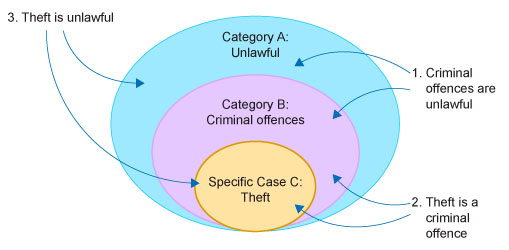1.1.1 Deductive reasoning
The most famous type of deductive reasoning is the syllogism. A classic example of this involves the ancient Greek philosopher Socrates:
- all men are mortal
- Socrates is a man
- therefore Socrates is mortal.
As legal reasoning is the subject of this course, the following legal syllogism can be used:
- criminal offences are unlawful
- theft is a criminal offence
- therefore theft is unlawful.
This syllogism is illustrated in Figure 2.
In the diagram the arrows and numbering illustrate the steps in the process. First, there is a ‘major premise’, a general statement that is known to be true. It describes two categories of things, one that fits inside the other. Second, there is a minor premise, another statement we know to be true, which engages with the smaller category of the major premise and the specific case at hand. The third step allows us to take what is known from the first two premises and conclude something new about the case, which is that it fits within the largest category. The circles in the diagram represent how the categories fit together in deductive reasoning: ‘B’ fits within ‘A’ and ‘C’ fits within ‘B’, so ‘C’ must also fit within ‘A’.
The syllogism can therefore be broken down as follows:
- major premise – criminal offences (category B) are unlawful (category A)
- minor premise – theft (case C) is a criminal offence (category B)
- conclusion – therefore theft (case C) is unlawful (category A).
The logic in this form of reasoning is certain. The conclusion must follow from the premises: A = B and B = C, so A = C. Put another way, because the category of ‘criminal offences’ is entirely contained within the category ‘unlawful’, and the specific case of theft is a member of the category of ‘criminal offences’, theft must also be a member of the category ‘unlawful’.
Activity 1 Drawing a conclusion from deductive reasoning
Consider the following major and minor premises and deduce the appropriate conclusions from them.
- a.All dogs are mammals.
Labradors are dogs.
- b.All dogs are reptiles.
Labradors are dogs.
- c.The ‘neighbour principle’ creates a duty of care.
Donoghue falls within the neighbour principle.
Comment
- a.Therefore Labradors are mammals.
- b.Therefore Labradors are reptiles
- c.Therefore Donoghue creates a duty of care.
The conclusions to (a) and (c) are correct, but you will have noticed that the conclusion in (b) is incorrect (Labradors are not in fact reptiles). This shows that deductive reasoning is not always reliable, if the premises are flawed or the logic is not applied correctly. You will return to this shortly.
It is worth noting from (c) that you can make a true statement about the law if you are given true premises without having that knowledge already (you will understand why this conclusion is true by the end of this unit). This is how deductive reasoning works. As long as the major and minor premises are true and the reasoning is applied correctly, the conclusion will be true.
While the logic is certain, however, this does not mean that all conclusions drawn using this method are necessarily true. In fact, the truth of the concluding statement is entirely dependent on the truth of the premises on which that conclusion is based and following the reasoning process properly. These are not guaranteed by the structure of the syllogism itself. The truth of the conclusion can be compromised in a number of ways:
- if the major or minor premise is in fact untrue
- if the major premise only applies to some of the cases in category B, meaning that it does not fit entirely within category A
- if the minor premise is true but unrelated to the categories in the major premise
- if the order of the logic of the categories gets mixed up in any way.
Deductive syllogisms depend on a strict order of logic that cannot easily be altered. The idea of deduction in general – reasoning from the general to the specific – is not quite so strict, but you have to make sure each category of objects fits entirely within the wider category above it to be certain of a categorical conclusion.
The important thing to remember about deductive reasoning at this stage is that the logic is flawless when applied correctly. If the premises are true and the statements are properly constructed in relation to one another, the conclusion will always be true. But the syllogism itself says nothing about the truth of the premises or the construction of the statements; if either of these is flawed then the conclusion is also fallible.

